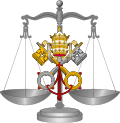Catholic authorization for publication

Imprimi potest or imprimi permittitur (Latin for 'it can be printed') is a declaration by a major superior of a religious institute of the Catholic Church that writings on questions of religion or morals by a member of the institute may be printed. [1] Superiors make such declarations only after censors charged with examining the writings have granted the nihil obstat , a declaration of no objection. Final approval can then be given through the imprimatur ('let it be printed') of the author's bishop or of the bishop of the place of publication. [2]
